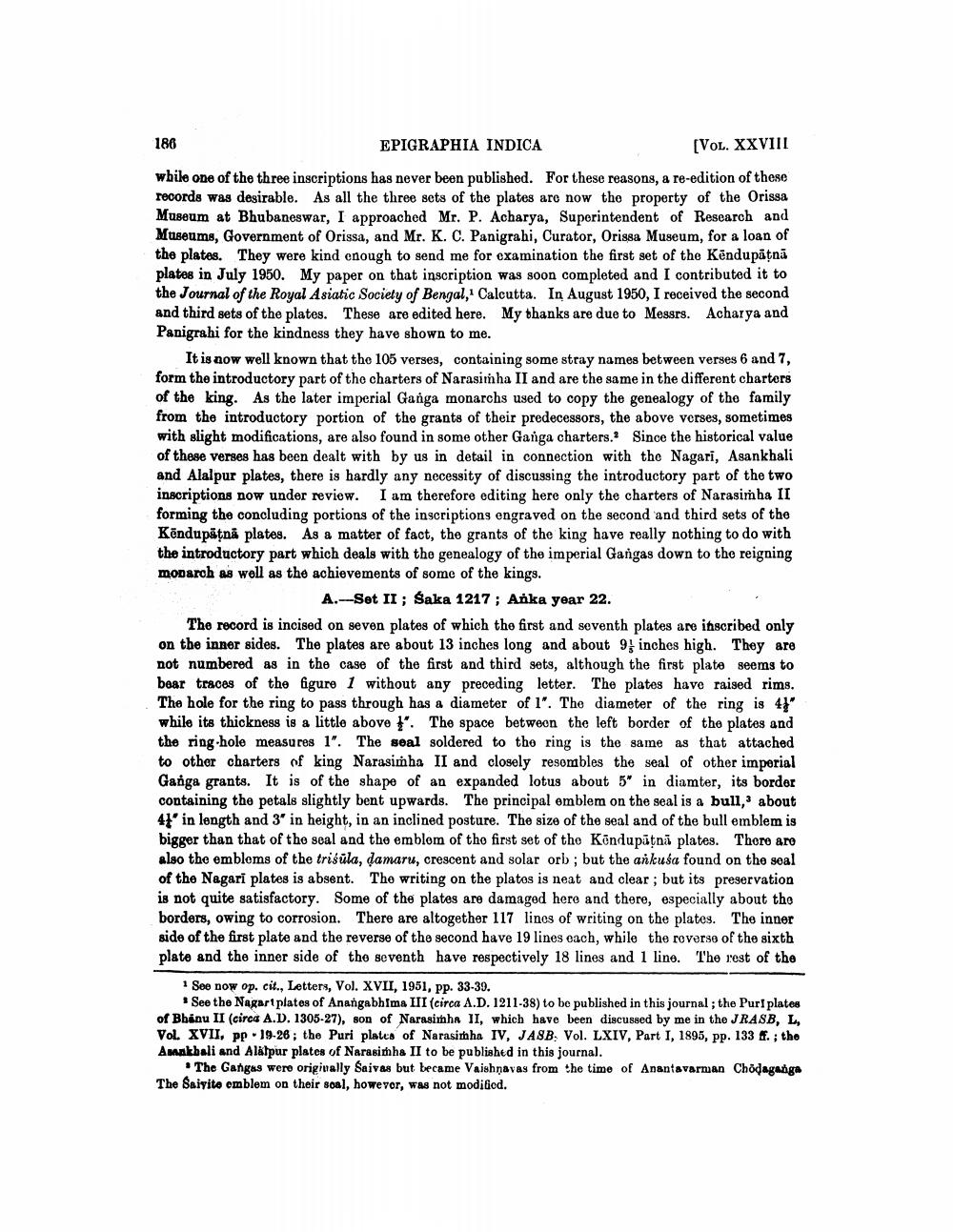________________
186
EPIGRAPHIA INDICA
[VOL. XXVIII
while one of the three inscriptions has never been published. For these reasons, a re-edition of these records was desirable. As all the three sets of the plates are now the property of the Orissa Museum at Bhubaneswar, I approached Mr. P. Acharya, Superintendent of Research and Museums, Government of Orissa, and Mr. K. C. Panigrahi, Curator, Orissa Museum, for a loan of the plates. They were kind enough to send me for examination the first set of the Kendupāṭnā plates in July 1950. My paper on that inscription was soon completed and I contributed it to the Journal of the Royal Asiatic Society of Bengal,1 Calcutta. In August 1950, I received the second and third sets of the plates. These are edited here. My thanks are due to Messrs. Acharya and Panigrahi for the kindness they have shown to me.
It is now well known that the 105 verses, containing some stray names between verses 6 and 7, form the introductory part of the charters of Narasimha II and are the same in the different charters of the king. As the later imperial Ganga monarchs used to copy the genealogy of the family from the introductory portion of the grants of their predecessors, the above verses, sometimes with slight modifications, are also found in some other Ganga charters. Since the historical value of these verses has been dealt with by us in detail in connection with the Nagari, Asankhali and Alalpur plates, there is hardly any necessity of discussing the introductory part of the two inscriptions now under review. I am therefore editing here only the charters of Narasimha II forming the concluding portions of the inscriptions engraved on the second and third sets of the Kendupăṭnā plates. As a matter of fact, the grants of the king have really nothing to do with the introductory part which deals with the genealogy of the imperial Gangas down to the reigning monarch as well as the achievements of some of the kings.
A.-Set II; Šaka 1217; Anka year 22.
The record is incised on seven plates of which the first and seventh plates are inscribed only on the inner sides. The plates are about 13 inches long and about 9 inches high. They are not numbered as in the case of the first and third sets, although the first plate seems to bear traces of the figure 1 without any preceding letter. The plates have raised rims. The hole for the ring to pass through has a diameter of 1". The diameter of the ring is 4" while its thickness is a little above. The space between the left border of the plates and the ring-hole measures 1". The seal soldered to the ring is the same as that attached to other charters of king Narasimha II and closely resembles the seal of other imperial Ganga grants. It is of the shape of an expanded lotus about 5" in diamter, its border containing the petals slightly bent upwards. The principal emblem on the seal is a bull,' about 41" in length and 3" in height, in an inclined posture. The size of the seal and of the bull emblem is bigger than that of the seal and the emblem of the first set of the Kendupāṭnā plates. There are also the emblems of the trisula, damaru, crescent and solar orb; but the ankusa found on the seal of the Nagari plates is absent. The writing on the plates is neat and clear; but its preservation is not quite satisfactory. Some of the plates are damaged here and there, especially about the borders, owing to corrosion. There are altogether 117 lines of writing on the plates. The inner side of the first plate and the reverse of the second have 19 lines each, while the reverse of the sixth plate and the inner side of the seventh have respectively 18 lines and 1 line. The rest of the
1 See now op. cit., Letters, Vol. XVII, 1951, pp. 33-39.
* See the Nagart plates of Anangabhima III (circa A.D. 1211-38) to be published in this journal; the Puri plates of Bhanu II (circa A.D. 1305-27), son of Narasimha II, which have been discussed by me in the JRASB, L, Vol. XVII, pp 19-26; the Puri plates of Narasimha IV, JASB: Vol. LXIV, Part I, 1895, pp. 133 ff.; the Asankhali and Alälpur plates of Narasimha II to be published in this journal.
.
The Gangas were originally Saivas but became Vaishnavas from the time of Anantavarman Chōdaganga The Saivite emblem on their soal, however, was not modified.




